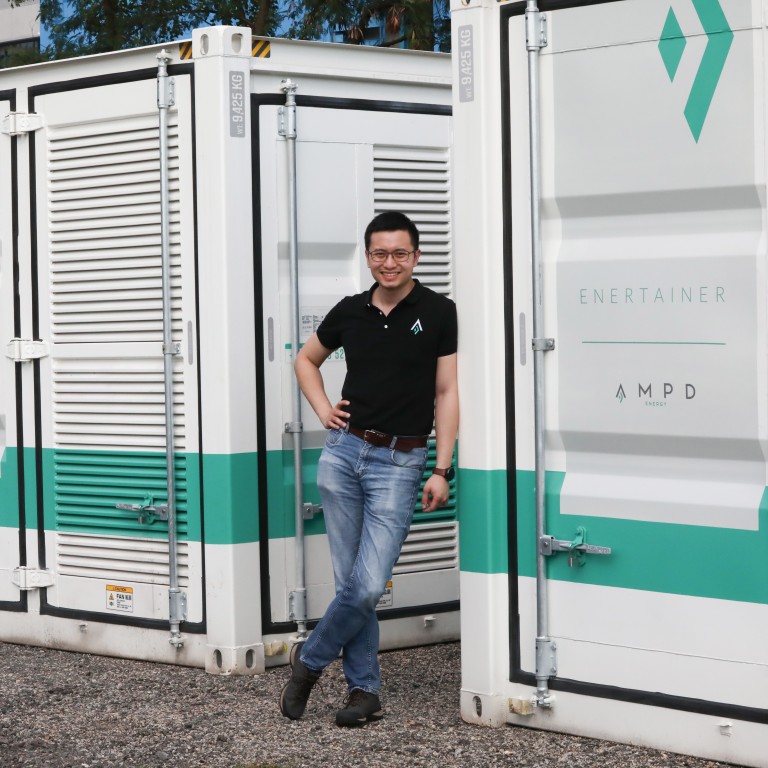
Hong Kong start-up Ampd Energy joins Gammon to decarbonise construction sites, swap diesel generators with batteries
- Ampd Energy’s nearly 70 battery-powered energy storage systems deployed in Hong Kong have reduced carbon dioxide emissions by 8,000 tonnes a year
- Data collected by Ampd’s systems allows construction firms to monitor their energy consumption and helps to improve productivity
Even accounting for the carbon emissions of electricity generation, the battery systems’ total carbon footprint was nearly 85 per cent less than that of diesel generators, he said.
That translates to a reduction of 8,000 tonnes of carbon dioxide emissions per year by the roughly 70 battery systems currently deployed by Ampd in Hong Kong, which aims to be carbon neutral by 2050. The city’s carbon emissions came to 68 million tonnes last year, BP estimated.

04:56
Hong Kong could slash carbon emissions 70% with more ambitious goals, says former observatory head
Part of the reduced carbon footprint of the battery systems comes from the lower carbon intensity of grid-supplied power compared to diesel.
The rechargeable battery systems, each consisting of over 30,000 lithium-ion battery cells – similar to those making up batteries of Tesla electric cars – power equipment such as cranes, pumps and arc welders.
The box-shaped mobile energy storage systems – 2.6 metres high and weighing nearly 8.5 tonnes – was the result of over a year of development in collaboration with construction and engineering contractor Gammon.
“They came to us in early 2018 with a challenge, which was whether it was possible to use these massive energy storage systems to power up entire construction projects, instead of diesel generators,” said Ng.
“We realised not only that it was technically possible, but there were also many benefits, such as a major reduction in on-site air pollution and noise from diesel generators that constrained work site operating hours.”
Hong Kong developers quicken adoption of proptech as opportunities arise across sector
Fuel combustion in places other than roads and power plants in 2019 contributed to 18 per cent of Hong Kong’s particulate matter small enough to be inhaled into lungs and cause adverse health effects, according to the Environmental Protection Department.
Volatile oil price, suboptimal energy efficiency of diesel generators, fire risks, refuelling needs and staff health risks have driven Gammon to search for an electric alternative, said its chief technology officer Paul Evans.
“Avoiding generators by using batteries is only one part of the decarbonisation story,” he said. “Unfortunately, much of the heavy equipment we use, such as piling equipment, does not have an electric equivalent currently. But we must be ready for the [eventual] transition … [towards] zero-emission construction sites.”
Gammon aims to slash its carbon emission per dollar of revenue by a quarter by 2025 from 2016.
Data collected by Ampd’s systems also gives construction firms new tools to monitor their energy consumption, besides enhancing productivity, Ng said.
Companies globally are increasingly required by regulators to disclose annually their carbon footprint.

06:55
What is China doing about climate change?
With operating costs up to 80 per cent lower than that of diesel generators, customers who chose to buy the systems can save up to 70 per cent in total equipment and operating costs over its lifetime – typically 10 years or longer, Ng said.
Those renting them can expect total costs to be similar to owning diesel generators, he added.
Ng expects Ampd’s storage systems deployed to at least double this year from last year.
It has amassed a small percentage of Hong Kong’s construction site energy market, he estimated, adding it has also deployed some units in Singapore and is exploring opportunities in Australia and Europe.
The systems are used in close to 50 major construction projects run by 24 construction firms and property developers in Hong Kong, including Gammon, Hip Hing, Paul Y Engineering, Chinachem Group and Sino Land.
Founded in 2014 and a former participant of Hong Kong Science and Technology Park’s start-up incubation programme, Ampd raised US$3.7 million of seed capital in 2016. It will soon close another round of venture capital fundraising of an undisclosed sum, Ng said.

